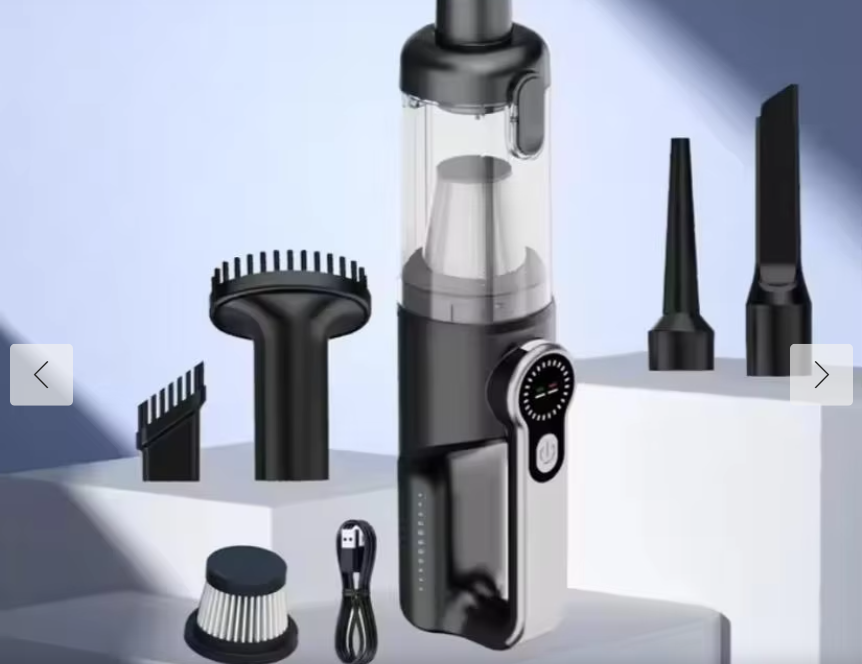Wichtige Komponenten eines Staubsauger für Autos
Funktionsweise des Motors und des Saugsystems
Im Herzen jedes Autostaubsaugers befindet sich der Motor, der den gesamten Saugprozess auslöst, der Schmutz und Dreck aus Sitzen und Teppichen entfernt. Beim Vergleich verschiedener Modelle stellen viele Nutzer fest, dass Staubsauger mit besseren Motoren in der Regel gründlicher reinigen. Warum ist das so? Die Stärke des Saugvermögens hängt vor allem von zwei Faktoren ab: dem Aufbau des Motors und der Geschwindigkeit, mit der er seine Umdrehungen pro Minute erreicht. Motoren, die schneller rotieren, sind in der Regel besser geeignet, um Verschmutzungen aus schwer zugänglichen Stellen zu entfernen. Die Unterscheidung zwischen Luftstrom und tatsächlicher Saugkraft ist entscheidend, um den richtigen Staubsauger für eine spezifische Reinigungssituation zu finden. Schließlich möchte niemand nach einer schnellen Reinigung noch gegen Staubklumpen unter dem Rücksitz kämpfen.
Bedeutung von Filtern und Staubbehältern
Die Filter in Autostaubsaugern leisten eine ziemlich gute Arbeit, um allerlei Dinge wie Staub, Pollen und jene winzigen Partikel einzufangen, die in der Luft schweben. Personen, die unter Allergien leiden, könnten speziell HEPA-Filter in Betracht ziehen, da diese besser darin sind, lästige Allergene festzuhalten. Wenn diese Filter ordnungsgemäß funktionieren, tragen sie dazu bei, dass die aus dem Staubsauger austretende Luft tatsächlich sauber bleibt, anstatt einfach nur schmutzige Luft umherzuverteilen. Vergiss zudem den Staubbehälter nicht! Wird dieser nicht beachtet, verstopft er schnell, was bedeutet, dass das gesamte System unnötig stark arbeiten muss. Manche bevorzugen Saugersysteme mit Beutel, während andere zu beutellosen Modellen greifen. Beutelmodelle fassen meist mehr Schmutz, benötigen jedoch regelmäßig neue Beutel. Beutellose Modelle müssen häufiger geleert werden, sparen aber langfristig Kosten für Ersatzbeutel. Wähle einfach das aus, das am besten in deine übliche Reinigungsroutine passt.
Schläuche, Zubehör und Accessoires
Autosauger werden mit verschiedenen Aufsätzen geliefert, die das Reinigen erheblich vereinfachen. Spaltwerkzeuge sind ideal für enge Stellen zwischen den Sitzen, während Bürstenaufsätze Polsterstoffe schonend reinigen. Die meisten Menschen unterschätzen, wie wichtig diese kleinen Extras tatsächlich sind, um Schmutzansammlungen in Ecken und entlang von Türverkleidungen zu entfernen. Auch der Schlauch spielt eine Rolle – längere Schläuche bieten mehr Reichweite, können aber leicht verknüllen, wenn sie nicht stabil genug sind. Flexible Schläuche biegen sich um Hindernisse, ohne zu knicken, und sparen so Zeit während der Reinigung. Für optimale Ergebnisse empfiehlt es sich, spezielle Düsen zu verwenden, die extra für die Reinigung von Fahrzeuginnenräumen entwickelt wurden. Diese entfernen Haustierhaare aus Ritzen im Armaturenbrett und Staub unter Gurtschlossern, wo herkömmliche Aufsätze nicht hinkommen.
Schritt-für-Schritt Staubsauger für Autos Wartungsroutine
Tägliche/Wöchentliche Reinigung: Ausleeren der Staubbehälter und Entfernen von Schmutz
Regelmäßige Wartung spielt bei Autoreinigern eine große Rolle. Das Leeren der Staubbehälter und Entfernen des gesamten Schmutzes im Inneren hilft, die Saugleistung aufrechtzuerhalten und verlängert die Lebensdauer des Geräts. Wenn Nutzer diesen grundlegenden Schritt vernachlässigen, treten Probleme wie Verstopfungen auf, die die Reinigungsleistung stark beeinträchtigen und auf Dauer sogar Teile im Inneren beschädigen können. Tatsächlich sorgt das Entfernen grober Verschmutzung in regelmäßigen Abständen dafür, dass alles reibungslos läuft, ohne den Motor zusätzlich zu belasten. Die meisten Nutzer stellen fest, dass es sich langfristig auszahlt, jede Woche etwas Zeit für schnelle Reinigungen einzuplanen. Der Reiniger bleibt effizient, bereitet auf Dauer keine Probleme und funktioniert insgesamt besser, wenn man sich an eine einfache Wartungsroutine hält.
Monatliche Filterreinigung und -austausch
Monatliches Reinigen der Filter und rechtzeitiger Austausch macht den entscheidenden Unterschied für eine gute Luftqualität und die effektive Funktionsweise des Staubsaugers. Diese Filter fangen Hausstaubmilben, Tierhaare und andere Partikel ein, die wir nicht in unseren Wohnräumen herumschweben haben wollen. Die meisten Hersteller empfehlen, die Filter alle paar Monate auszutauschen, abhängig davon, wie intensiv der Staubsauger genutzt wird. Wenn die Filter zu lange verwendet werden, verstopfen sie und beginnen, Partikel wieder in die Luft abzugeben. Gereinigte Filter halten zudem länger im Gerät selbst, was langfristig Kosten spart. Und ehrlich gesagt möchte niemand schmutzige Luft einatmen, während man versucht, den Boden zu reinigen. Vergisst nicht diese kleinen Plastikboxen unter dem Bett, in die die alten Filter gehören – sie sind schließlich nicht umsonst dort!
Jahreszeitrückschau für optimale Leistung
Eine gründliche Reinigung des Autostaubsaugers in regelmäßigen Abständen macht tatsächlich einen großen Unterschied hinsichtlich seiner Leistung über die Zeit. Überprüfen Sie alle Teile, insbesondere den Motor und das Saugsystem, um kleinere Probleme frühzeitig zu erkennen, bevor sie später zu größeren Störungen führen. Wenn wir solche Wartungsarbeiten regelmäßig durchführen, verhindern wir Ausfälle genau dann, wenn wir unseren Staubsauger am meisten benötigen – beispielsweise während der Reisesaison oder nach Fahrten durch staubige Gegenden. Die Wahrheit ist einfach: Diese Geräte halten ohne angemessene Pflege nicht lange. Die saisonale Wartung sorgt dafür, dass alles reibungslos funktioniert, und spart langfristig auch Geld. Die meisten Menschen denken erst an ihren Autostaubsauger, wenn etwas nicht mehr funktioniert. Doch etwas Aufmerksamkeit jetzt sorgt dafür, dass der Staubsauger genau dann gut arbeitet, wenn es am wichtigsten ist.
Behandlung von häufigen Problemen beim Auto-Staubsauger
Verlust der Saugkraft: Diagnose von Lecks und Verstopfungen
Wenn ein Autostaubsauger an Saugkraft verliert, liegt das meistens daran, dass irgendwo Lecks oder Verstopfungen vorliegen. Ein beschädigtes Rohr zum Beispiel lässt Luft entweichen und beeinträchtigt die Saugleistung stark. Regelmäßige Kontrollen der Schläuche auf eingeklemmte Fremdkörper oder kleine Risse helfen dabei, einen Leistungsverlust zu verhindern. Auch die Filter sollten nicht vergessen werden regelmäßige Reinigung stellt sicher, dass die Luft ungehindert durch das System fließen kann und Probleme gar nicht erst entstehen. Es macht einen großen Unterschied, wenn man frühzeitig solche Probleme erkennt. Die meisten stellen fest, dass ihre Staubsauger länger halten und besser funktionieren, wenn sie proaktiv Wartung betreiben, anstatt zu warten, bis etwas komplett kaputt ist.
Behandlung von Verstopfungen in Schläuchen und Düsen
Wenn es darum geht, dass Staubsauger an Saugkraft verlieren, sind verstopfte Schläuche und Düsen in den meisten Fällen das Hauptproblem. Deshalb ist es wirklich wichtig, eine regelmäßige Wartung durchzuführen, um solche Probleme von vornherein zu vermeiden. Kleinere Verstopfungen lassen sich meist erkennen, wenn man wöchentlich eine Überprüfung vornimmt, bevor sie zu größeren Problemen werden. Für jene schwer erreichbaren Stellen im Inneren des Schlauches, an denen sich Schmutz ansammelt, macht die Verwendung einer hochwertigen, flexiblen Bürste einen großen Unterschied. Diese Bürsten bewegen sich durch das Rohr und lösen Ablagerungen, die auf keine andere Weise entfernt werden könnten. Die meisten Menschen unterschätzen, wie vorhersehbar die Muster von Verstopfungen eigentlich sind, sobald man darauf achtet. Wer erkennt, welche Bereiche zuerst verschmutzen, kann effizientere Reinigungsabläufe entwickeln und somit unerwartete Ausfälle reduzieren. Ein wenig Wissen trägt dazu bei, den Staubsauger ohne ständige Unterbrechungen reibungslos laufen zu lassen.
Behandlung von merkwürdigen Geräuschen oder Überhitzung
Seltsame Geräusche, die von einem Staubsauger kommen, deuten normalerweise auf Probleme im Inneren hin, die bald behoben werden müssen. Überhitzung entsteht häufig, wenn die Luft nicht richtig durch das System zirkulieren kann, möglicherweise weil die Filter verstopft sind oder der Schlauch irgendwo eingeknickt ist. Es ist wichtig, solche Probleme schnell zu beheben, denn wenn man sie ignoriert, entstehen meist größere Probleme, die später deutlich mehr Geld kosten. Wenn Nutzer Probleme frühzeitig angehen, funktionieren ihre Staubsauger länger und besser. Die meisten Privatanwender stellen fest, dass dies besonders dann Sinn macht, wenn sie bereits Kosten für Ersatzgeräte aufgrund von vernachlässigter Wartung hatten.
Best Practices zur Verlängerung der Lebensdauer Ihres Autostaubsaugers
Richtige Lagerung zur Vermeidung von Schäden
Die Art und Weise, wie wir unsere Autostaubsauger aufbewahren, macht den entscheidenden Unterschied, wie lange sie halten und ordnungsgemäß funktionieren. Wenn man sie an einem kühlen und trockenen Ort aufbewahrt, vermeidet man Probleme, die durch Feuchtigkeit entstehen und die Verkabelung im Inneren beschädigen könnten. Wenn man das Gerät nach dem Gebrauch aufbewahrt, sollte man es aufrecht stehen lassen, damit die flexiblen Schläuche und verschiedenen Düsen nicht verbogen werden. Ein kurzer Blick auf den Aufstellungsort des Staubsaugers von Zeit zu Zeit verhindert Staubansammlungen im Bereich des Motorenfachs, was langfristig die Saugkraft beeinträchtigen kann. Wenn man solch grundlegenden Aufbewahrungspraktiken folgt, stellen die meisten Nutzer fest, dass ihre tragbaren Staubsauger jahrelang zuverlässig funktionieren, anstatt bereits nach wenigen Monaten kaputt zu gehen.
Vermeidung von Überbeanspruchung und falscher Anwendung
Das Einhalten der Konstruktionsgrenzen eines Autostaubsaugers hilft, unnötigen Verschleiß der Maschine im Laufe der Zeit zu vermeiden. Die meisten Handbücher enthalten Gebrauchstipps, die Besitzer vor übermäßig intensivem Reinigen lesen sollten. Versuchen Sie nicht, Dinge wie Sand oder Kies aufzusaugen, da diese Materialien die Innenteile stark beanspruchen und die Lebensdauer verkürzen können. Wenn Benutzer erst einmal verstanden haben, wofür ihr Staubsauger tatsächlich ausgelegt ist, erzielen sie in der Regel bessere Ergebnisse und stellen gleichzeitig sicher, dass das Gerät länger zwischen den Austauschintervallen hält. Die richtige Herangehensweise spart langfristig Geld und sorgt dafür, dass das Fahrzeug über mehrere Monate hinweg sauberer aussieht.
Verwendung kompatibler Ersatzteile
Die Verwendung von Ersatzteilen, die vom Hersteller empfohlen werden, macht den entscheidenden Unterschied, um eine ordnungsgemäße Funktion des Autostaubsaugers sicherzustellen. Teile, die wirklich passen, funktionieren in der Regel auch besser und helfen dabei, Probleme zu vermeiden, wie z. B. den Verlust der Garantieabdeckung oder eine abnehmende Leistung des Geräts im Laufe der Zeit. Gelegentlich zu prüfen, ob neue Komponenten verfügbar sind, könnte einige Besitzer überraschen, da Hersteller häufig Verbesserungen einführen, die die Reinigungsleistung steigern oder den Energieverbrauch reduzieren. Wer bei der Wahl der Ersatzteile auf offizielle Empfehlungen achtet, macht sich die langfristige Pflege wesentlich einfacher. Auf diese Weise verlängert sich die Lebensdauer des Staubsaugers, und er bleibt zuverlässig leistungsfähig, ohne unerwartete Ausfälle im Laufe der Zeit.
FAQ
Was sollte ich bei einem Motor für einen Auto-Staubsauger beachten?
Suchen Sie nach einem Motor mit hoher Effizienz und hohen Umdrehungen pro Minute (RPM), da diese in der Regel stärkere Saugkraft und eine effektivere Reinleistung anzeigen.
Wie oft sollte ich die Filter meines Auto-Staubsaugers reinigen oder ersetzen?
Filter sollten monatlich gereinigt oder ersetzt werden, wobei dabei den Herstelleranweisungen entsprechend der Nutzung gefolgt wird, um die Luftqualität und die Saugleistung zu erhalten.
Welche Lösungen gibt es für das Verlieren von Saugkraft?
Häufige Lösungen umfassen die Überprüfung auf Schlauchlecks, Verstopfungen oder Filterverstopfungen. Sicherzustellen, dass diese Komponenten sauber und unbeschädigt sind, kann die optimale Saugkraft wiederherstellen.

